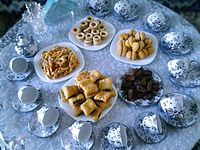
Back Idul Fitri ACE Eid-oel-Fiter Afrikaans Fest des Fastenbrechens ALS عيد الفطر Arabic عيد الفطر ARZ ঈদ-উল-ফিটৰ Assamese Eid al-Fitr AST КӀалбиччанкъо AV ईद उल-फ़ित्र AWA Ramazan bayramı Azerbaijani
| Eid Al-Fitr | |
|---|---|
From top: Muslims performing the Eid prayer at Süleymaniye Mosque, Istanbul, Turkey; cakes and sweets, which are popularly consumed during the celebration in Algeria. | |
| Official name | Arabic: عيد الفطر, romanized: Eid al-Fiṭr |
| Also called | Festival of Breaking the Fast, Lesser Eid, Sweet Eid, Sugar Feast |
| Observed by | Muslims |
| Type | Islamic |
| Significance | Commemoration to mark the end of fasting in Ramadan |
| Celebrations | Eid prayers, charity, social gatherings, festive meals, gift-giving, dressing up |
| Date | 1 Shawwal[1] |
| 2025 date | 31 March – 2 April[a][2] |
| 2026 date | 20 March – 22 March |
| Related to | Ramadan, Eid al-Adha |
| Part of a series on |
| Islamic culture |
|---|
| Architecture |
| Art |
| Clothing |
| Holidays |
| Literature |
| Music |
| Theatre |
Eid al-Fitr (/ˌiːd əl ˈfɪtər, -trə/ EED əl FIT-ər, -rə; Arabic: عيد الفطر, romanized: ʿĪd al-Fiṭr, IPA: [ʕiːd al ˈfɪtˤr]) is the earlier of the two official holidays celebrated within Islam (the other being Eid al-Adha). Eid al-Fitr is celebrated by Muslims worldwide because it marks the end of the month-long dawn-to-dusk fasting of Ramadan.[4] Eid al-Fitr falls on the first day of Shawwal in the Islamic calendar; this does not always fall on the same Gregorian day, as the start of any lunar Hijri month varies based on when the new moon is sighted by local religious authorities. The holiday is known under various other names in different languages and countries around the world. The day is also known as the First Eid or as the Lesser Eid (Arabic: العيد الصغير, romanized: al-ʿĪd al-Ṣaghīr) by some Muslim communities.[5][6]
Eid al-Fitr has a particular salah that consists of two rakats generally performed in an open field or large hall. It may only be performed in congregation (jamāʿat) and features seven additional Takbirs (raising of the hands to the ears whilst reciting the Takbir, saying "Allāhu ʾAkbar", meaning "God is the greatest"). In the Hanafi school of Sunni Islam, there are three Takbirs at the start of the first rakat and three just before rukūʿ in the second rakat.[7] Other Sunni schools usually have 12 Takbirs, similarly split in groups of seven and five. In Shia Islam, the salat has six Takbirs in the first rakat at the end of Tilawa, before rukūʿ, and five in the second.[8] Depending on the juristic opinion of the locality, this salat is either farḍ (فرض, obligatory) or mustaḥabb (strongly recommended). After the salat, Muslims celebrate the Eid al-Fitr in various ways with food being a central theme,[9] which also gives the holiday the nickname "Sweet Eid" or "Sugar Feast".[10][11]
- ^ a b Cite error: The named reference
ummalqurawas invoked but never defined (see the help page). - ^ Singh, Bhupinder (2 April 2023). "When Is Eid Al-Fitr 2023? Eid Al-Fitr History, Significance, All You Need To Know About Holy Festival". The Times of India. Archived from the original on 10 April 2023. Retrieved 10 April 2023.
- ^ "Gregorian vs Hijri Calendar". islamicfinder.org. Archived from the original on 24 June 2020. Retrieved 4 June 2019.
- ^ Barr, Sabrina. "Eid al-Adha 2019: When is it, How is it celebrated and How to Wish Someone Happy Eid". independent. Archived from the original on 11 August 2019. Retrieved 11 August 2019.
- ^ Cite error: The named reference
TheNation2020-06-30-01awas invoked but never defined (see the help page). - ^ Elias, Jamal J. (1999). Islam. Routledge. p. 75. ISBN 0415211654.
- ^ "Eid al-Fitr and the six supplementary fasts of Shawwal". Inter-islam.org. Archived from the original on 26 July 2013. Retrieved 11 August 2013.
- ^ Namaz (prayer) Eid Fitr Archived 13 February 2018 at the Wayback Machine yjc.ir Retrieved 4 June 2018
- ^ "How Do Muslims Celebrate Eid? The Beauty of Eid Explained". Islam Faith. 21 August 2018. Archived from the original on 10 May 2021. Retrieved 10 May 2021.
- ^ "What food is eaten during the Muslim festival of Eid al-Fitr?". Independent.co.uk. 23 May 2020. Archived from the original on 14 January 2021. Retrieved 12 May 2021.
- ^ "How is Eid al-Fitr celebrated around the world? – BBC Bitesize". Bbc.co.uk. Archived from the original on 10 May 2021. Retrieved 17 December 2021.
Cite error: There are <ref group=lower-alpha> tags or {{efn}} templates on this page, but the references will not show without a {{reflist|group=lower-alpha}} template or {{notelist}} template (see the help page).

